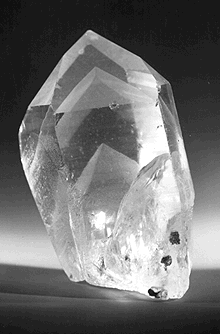 Gemstones are not plentiful. Gemstones do not form "ore" deposits in the normal sense.
Gemstones are not plentiful. Gemstones do not form "ore" deposits in the normal sense.
Gems, when present at all, tend to be scattered sparsely throughout a large body of rock or to have crystallized as small aggregates or fill veins and small cavities.
Even stream gravel concentrations tend to be small--a few stones in each of several bedrock cracks, potholes, or gravel lenses in a stream bed.
Quartz with phantoms, Brazil
Photograph courtesty of
The Smithsonian Institution
The average grade of the richest diamond kimberlite pipes in Africa is about 1 part diamond in 40 million parts "ore." Kimberlite, a plutonic igneous rock, ascends from a depth of at least 100 kilometers (60 miles) to form a diatreme (narrow cone-shaped rock body or "pipe"). Moreover, because much diamond is not of gem quality, the average stone in an engagement ring is the product of the removal and processing of 200 to 400 million times its volume of rock.
Examples of geologic environments in which gemstones are found:
Pegmatite--a coarse-grained intrusive igneous rock body, occurring as dikes (a tabular-shaped body), lenses, or veins in the surrounding rock.
Stream gravels (placers)--deposits of heavier and more durable than average minerals that have been eroded out of the original rock. Often tourmaline, beryl, and many other gem-quality minerals have eroded out of the original rock in which they formed and have moved and been concentrated locally by water in streams. Sapphires in Judith Basin County, Montana, were first found when the gravels were worked for gold from 1895 to 1930.
Metamorphic rocks--rocks that have been altered by great heat, pressure, or both. Garnet, for example, is commonly found as crystals in gneiss and mica schist.